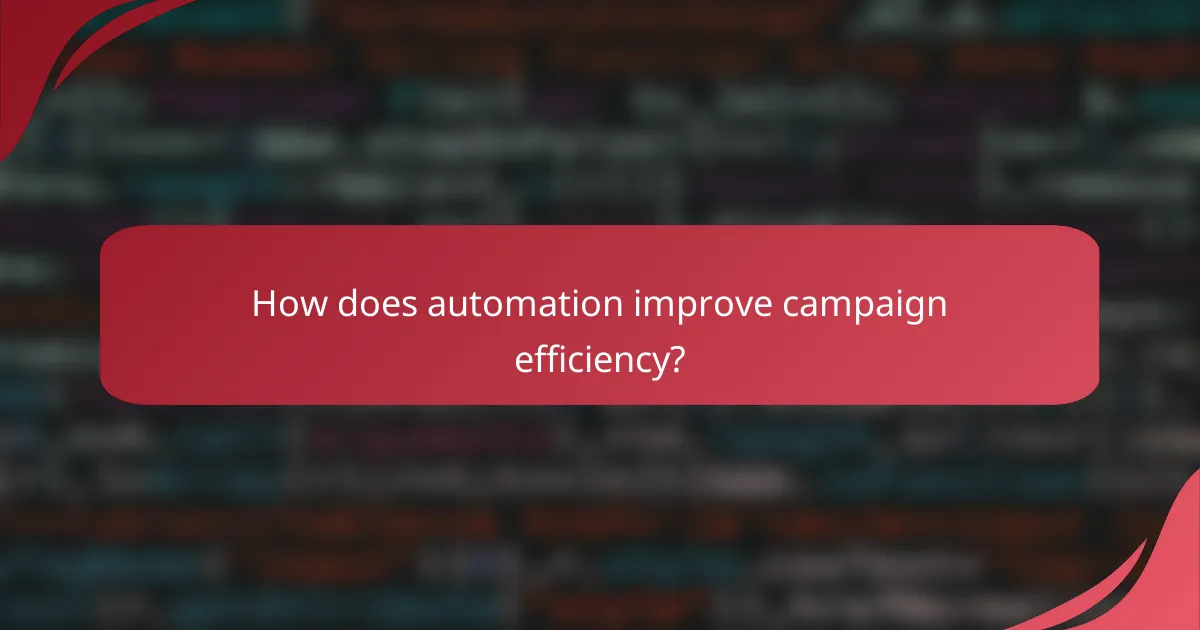AI-powered campaigns revolutionize marketing by enhancing targeting, personalization, and automation. By analyzing extensive customer data, businesses can create tailored experiences that resonate with individual preferences, leading to improved engagement and conversion rates. Additionally, automation streamlines processes, allowing for real-time adjustments and more efficient resource allocation, ultimately driving better campaign results.

How can AI enhance targeting in e-commerce campaigns?
AI enhances targeting in e-commerce campaigns by analyzing vast amounts of customer data to deliver personalized experiences. This technology allows businesses to identify specific customer preferences and behaviors, enabling more effective marketing strategies that resonate with individual shoppers.
Behavioral targeting techniques
Behavioral targeting techniques focus on analyzing users’ online actions to tailor marketing messages. By tracking browsing history, purchase patterns, and engagement levels, AI can predict what products a customer is likely to buy next. For instance, if a user frequently views athletic shoes, targeted ads for new arrivals in that category can be displayed.
Implementing these techniques requires robust data collection and analysis systems. Businesses should ensure they comply with data protection regulations, such as GDPR in Europe, while gathering insights to refine their targeting efforts.
Demographic segmentation strategies
Demographic segmentation strategies involve categorizing customers based on characteristics such as age, gender, income, and education level. AI can analyze demographic data to create targeted campaigns that appeal to specific groups. For example, a luxury brand might focus on high-income individuals aged 30-50 for its premium products.
To effectively utilize demographic segmentation, businesses should regularly update their customer profiles and adjust their marketing messages accordingly. This ensures that campaigns remain relevant and engaging for each demographic segment.
Geolocation-based targeting
Geolocation-based targeting uses a customer’s physical location to deliver tailored marketing messages. AI can analyze location data to determine which products or promotions are most relevant to shoppers in a specific area. For example, a local restaurant might send special offers to customers within a certain radius.
Businesses should consider local preferences and cultural nuances when implementing geolocation targeting. This approach can significantly enhance customer engagement and drive foot traffic to physical stores.
Predictive analytics for customer behavior
Predictive analytics leverages AI to forecast future customer behavior based on historical data. By identifying trends and patterns, businesses can anticipate what products customers are likely to purchase and when. For instance, if data shows a spike in sales of winter clothing in October, retailers can prepare targeted promotions ahead of time.
To maximize the effectiveness of predictive analytics, companies should continuously refine their models with new data. This iterative process helps maintain accuracy and relevance in targeting strategies.
Real-time data integration
Real-time data integration allows businesses to access and analyze customer information as it happens. This capability enables immediate adjustments to marketing campaigns based on current customer interactions. For example, if a customer abandons their cart, an AI system can trigger a follow-up email with a discount offer.
Implementing real-time data integration requires robust technology infrastructure and data management practices. Companies should ensure they have the necessary tools to collect, analyze, and act on data swiftly to enhance customer targeting efforts.

What personalization methods can be applied using AI?
AI can enhance personalization through various methods that tailor content and experiences to individual users. These methods leverage data analytics and machine learning to deliver relevant information, improving engagement and conversion rates.
Dynamic content recommendations
Dynamic content recommendations use AI algorithms to analyze user behavior and preferences in real-time, delivering personalized content based on this data. For example, an e-commerce site might show products that align with a user’s past purchases or browsing history. This approach can significantly increase user engagement and drive sales.
To implement dynamic content effectively, ensure your data collection practices comply with privacy regulations like GDPR. Regularly update your algorithms to reflect changing user preferences and trends.
Personalized email marketing
Personalized email marketing utilizes AI to segment audiences and tailor messages to individual preferences, increasing open and click-through rates. By analyzing user data, businesses can send targeted promotions or content that resonates with specific segments, such as past purchasers or newsletter subscribers.
To maximize effectiveness, consider A/B testing different email formats and subject lines. Monitor engagement metrics to refine your strategy continuously and avoid overwhelming users with excessive emails.
Customized landing pages
Customized landing pages are designed using AI to adapt content based on user demographics, behavior, or referral sources. This personalization can lead to higher conversion rates as users encounter relevant information tailored to their interests.
When creating customized landing pages, ensure that the messaging aligns with the user’s journey. Use clear calls-to-action and test different layouts to determine what resonates best with your audience.
AI-driven product suggestions
AI-driven product suggestions analyze user interactions and preferences to recommend items that are likely to interest them. This method is commonly used in online retail, where algorithms suggest complementary products based on what a user is viewing or has previously purchased.
To implement effective product suggestions, utilize collaborative filtering and content-based filtering techniques. Regularly review the performance of your recommendations and adjust your algorithms to enhance accuracy and relevance.

How does automation improve campaign efficiency?
Automation enhances campaign efficiency by streamlining processes, reducing manual effort, and enabling real-time adjustments. This leads to faster execution of marketing strategies and more effective resource allocation, ultimately driving better results.
Automated ad placements
Automated ad placements allow marketers to use algorithms to determine the best locations for their advertisements across various platforms. This technology analyzes user behavior and preferences to optimize ad visibility and engagement.
For example, programmatic advertising can adjust bids in real-time, ensuring that ads are shown to the right audience at the right time. This can significantly reduce costs while maximizing reach and impact.
Workflow automation tools
Workflow automation tools help streamline repetitive tasks within marketing campaigns, such as email scheduling, social media posting, and lead tracking. By automating these processes, teams can focus on strategy and creative work instead of manual execution.
Popular tools like HubSpot and Zapier enable integration across platforms, allowing for seamless data transfer and task management. This can lead to improved collaboration and faster project turnaround times.
AI chatbots for customer interaction
AI chatbots enhance customer interaction by providing instant responses to inquiries, guiding users through purchasing processes, and collecting feedback. These bots operate 24/7, ensuring that customer support is always available.
Implementing chatbots can reduce response times to seconds, improving customer satisfaction and freeing up human agents for more complex issues. Businesses should ensure that their chatbots are well-trained to handle common queries effectively.

What are the key criteria for selecting AI tools?
When selecting AI tools for campaigns, consider integration capabilities, scalability, and cost-effectiveness. These criteria ensure that the tools can fit seamlessly into your existing systems, grow with your needs, and provide value without overspending.
Integration capabilities
Integration capabilities refer to how well the AI tools can connect with your current marketing platforms and data systems. Look for tools that offer APIs or pre-built connectors to popular software like CRM systems, email marketing platforms, and analytics tools.
For example, a tool that integrates with Salesforce can enhance your customer relationship management by providing AI-driven insights directly within the platform. Ensure that the integration process is straightforward to avoid unnecessary delays and complications.
Scalability of solutions
Scalability is crucial for accommodating growth in your campaigns. Choose AI tools that can handle increasing data volumes and user demands without a drop in performance. This means they should be able to support more users, data inputs, and complex algorithms as your needs evolve.
For instance, a scalable solution might allow you to start with a basic package and upgrade to more advanced features as your business expands. Assess whether the pricing structure supports this growth without significant cost increases.
Cost-effectiveness
Cost-effectiveness evaluates whether the benefits of the AI tools justify their expenses. Consider not only the initial purchase price but also ongoing costs such as subscriptions, maintenance, and training. Look for tools that offer a clear return on investment (ROI).
A practical approach is to compare the costs of various AI tools against the expected improvements in efficiency or revenue. For example, if a tool can automate tasks that save your team several hours a week, calculate the potential savings in labor costs to determine its value.

What are the emerging trends in AI-powered campaigns?
Emerging trends in AI-powered campaigns include enhanced targeting, personalized content delivery, and increased automation. These advancements enable marketers to create more effective strategies that resonate with consumers, ultimately driving engagement and conversions.
Voice search optimization
Voice search optimization is becoming essential as more consumers use voice-activated devices to search for products and services. This trend requires marketers to adapt their SEO strategies to accommodate natural language queries and conversational phrases.
To optimize for voice search, focus on long-tail keywords and question-based phrases that reflect how people speak. For example, instead of targeting “best running shoes,” consider “what are the best running shoes for flat feet?” This approach aligns with the way users phrase their inquiries when using voice search.
Additionally, ensure your website is mobile-friendly and loads quickly, as voice searches often occur on mobile devices. Implementing structured data can also enhance your visibility in voice search results, making it easier for AI assistants to pull relevant information from your site.


